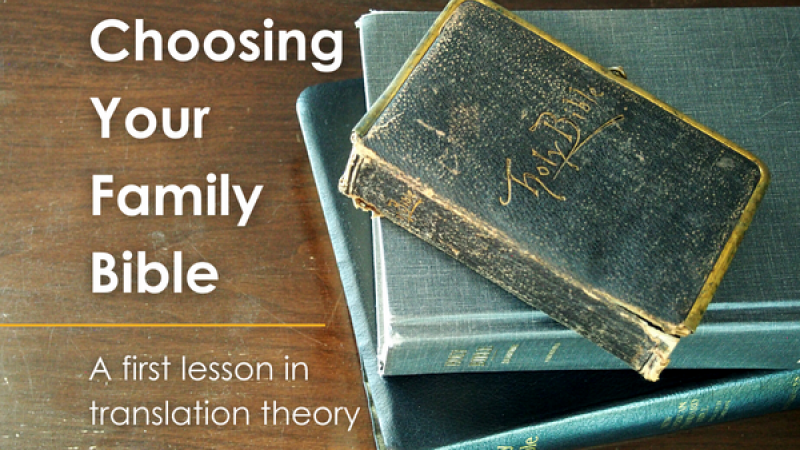Choosing a Family Bible: A first lesson in translation theory

A friend, who is an Anglican priest of several decades’ experience, once advised an adult Bible study, “Be careful what you memorize.” His point was that once a passage of Scripture is memorized, it is internalized and often fossilized, in our hearts. Anyone who has ever had a newer version of the Lord’s Prayer foisted unexpectedly on them will understand this. It can be very disorienting to suddenly ask forgiveness of debts when we have for years requested “forgive us our trespasses.”
Because of its seemingly timeless poetry, many Christians still prefer the King James Bible for memorization, and I admit that reading Luke 2, Psalm 23 and the Our Father in any other version seems a bit ill-fitting in my mouth, as I memorized them from the King James as a child. Nonetheless, the older language often fails to communicate, as English has changed a little in over four hundred years. It can be challenging for someone reading English as a second language, for children, for people with learning disabilities, or even for those of us whose version of English is a little more twenty-century. This is why many people ask me for advice in choosing the “best” Bible version for their family.
While reading the Bible in your second language is profitable- I dearly love reading the Bible in French as it slows me down and forces me to consider the words before me- I will presume that you are in the habit of reading an English language Bible and are quite probably a native speaker of English. This brings us to the question of the “best” English translation.
Dynamic Equivalent or Literal Translation?
Translation itself is an art, not a science. Every year in the classroom I have the equivalent of the following conversation:
Student A, let’s call her Sincerity, asks: “I thought you said that word means ‘to speak?’”
“Yes, it does.”
“But my classmate just translated it as ‘to say.’ Isn’t he wrong?”
“No, he isn’t. They are both valid translations.”
Student B, whom we will call Creativity, then asks “but why did you mark my answer wrong when I translated it as ‘to shout?’”
As adults who are not currently in the thick of translating a nuanced and thrilling passage of Scripture, we can probably see where Creativity has gone wrong here. Shouting is not the same thing as speaking or saying, and should she be in doubt, she can easily discern the difference by attempting all these actions in her local library.
Where Sincerity has gone astray is a little more subtle for most students. She has failed to see that her original word has no one simple English equivalent but a semantic range- a range of meaning- within her English translation must fall. In the nuances of English there will be times when she prefers to translate the word as “speak” and others when “say” will better fit the context, but both are within the original word’s range of meaning, as perhaps will she find “tell” which may not be listed in her textbook’s glossary at all. As she grows in the language, she will discover dictionary entries for single words that are multiple pages long, but for now she has a limited view of each word, because she is learning.
Deciding whether a translation fits into the semantic range of the original word is often a significant challenge for students as they wrestle with nuance and tone. Adding in poetic rhythm, which is often lost in translation, complex idiom which usually fails to translate, and the nuances of culture, geography, and the languages itself can make it utterly impossible to translate a text word for word and expect it to make sense. Students are often shocked to find that sometimes one word must be translated with a phrase in English, another word is not translated at all, and a third has nuance that must be determined from context. They expect that they can always translate the text literally and are often surprised when they are unable to do so.
In translation theory there are two major paradigms for dealing with these untranslatable texts. We can maintain word-for-word (literal) equivalency as best we are able, or we can maintain thought-for-thought authenticity (dynamic equivalent). The literal translation gives us a better understanding of the original language behind the English words, but the dynamic equivalent often preserves more of the imagery and idiom.
As an example, encountered by this year’s Hebrew students, Jonah 2 describes Jonah’s prayer as his call “out of the belly of Sheol.” That is a fine literal translation, but my question to the students was whether their reader would understand what Sheol is. Would it be better to translate the word as hades, the land of the dead, or even hell? And if they choose any of these, what do bellies have to do with it all? After some lively conversation they settled on “from the depth of hell” which seems to preserve a balance between a literal and a dynamic equivalent translation.
Literal translations can be difficult to read out loud, challenging for people reading in their second language, and unworkable for small children. Dynamic equivalents can be lively and often elegantly crafted but involve more of the interpreter’s own ideas about the text.
So how do you choose a family Bible? First, select an up-to-date translation. While the Bible itself does not change, the English language does. In addition, every year scholars find new fragments of ancient texts, better synthesize the linguistic record we have, and better understand the history and culture represented in these varied and beautiful texts. None of this will significantly change your Bible translation, but it will contribute to a richer understanding of the world from which it came.
Second, consider your children’s reading levels, and your own. When my children were younger, I chose a solid dynamic equivalent and allowed them to graduate to a more literal Bible as they grew. This meant that now each of them has two childhood Bibles, and they are now able to see the nuances in the text more clearly, even though to my chagrin none of them has continued with Greek past a basic level.
Third, be sure that you are purchasing a recognized translation rather than a paraphrase. A paraphrase can leave details out, over-interpret a text, or even under-interpret it. Recognized translations that were formed by committees (rather than individuals) are the most likely to have some of the linguistic rough edges sanded down.
So, what are some good examples? If you like an easy to read (late elementary school level) dynamic equivalent, I suggest a New Living Translation. Open it up, and if it feels right for reading out loud, it is likely a good fit for your family. If you prefer a more advanced reading level and something slightly more literal (while remaining in the dynamic equivalent camp) your New International Version will likely hit the spot. Those of us who prefer a more word-for-word translation tend toward the New Revised Standard Version, or even more in the literal camp the American Standard Version, the Revised Standard Version or the English Standard Version. (Though in the case of the ESV, it has often been critiqued for not preserving gender-inclusive language where the original Greek text does so. Yes, the ESV may, in fact, be more “conservative” than the Greek New Testament itself.)
Which do I have on my shelves? All of the above, of course! I find that one English translation is never enough. When leading a Bible study, I often tell the participants to bring whatever Bible they have on hand. The variety of translations can be enlightening. Seeing where they differ is a great place to start asking questions and engaging the text at a deeper level. In other words, that is where the fun is found.
Alas, in the end, all translations will lose something, too. Poetry, alliteration, imagery, and allusions are often untranslatable. For that, only the blessed languages will help.






